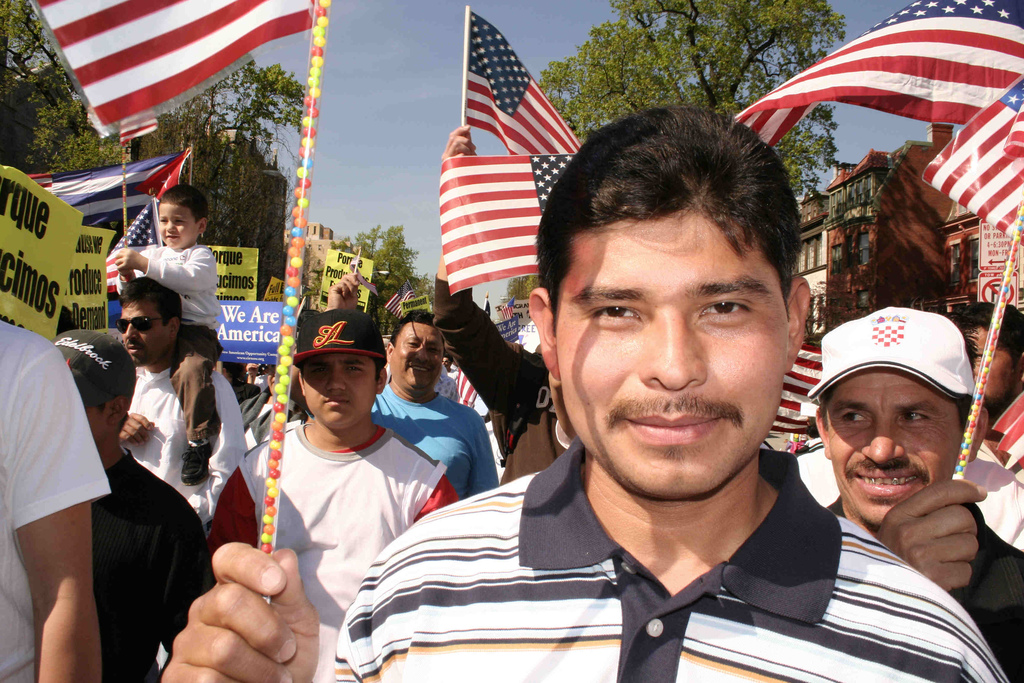Most people who have been following the political climate over the past few decades will notice how increasingly polarized it has become. One of the markers of this division is the partisan divide over immigration, which has been and will continue to play a huge role in the upcoming presidential election cycle. And one of the reasons that Republicans and Democrats are so split on the issue may be their links to specific demographic groups in the American electorate that are changing their own views.
In the Republican Party, the immigration rhetoric has taken a further turn to the right due to the increase in exurban working class voters in its ranks. According to a Pew Research Center poll conducted this spring, more than 60 percent of GOP voters believe that immigrants today are more of a burden than a benefit on our society, and Tea Partiers are even more opposed towards lenient immigration policy than other Republicans. This general viewpoint is one not only espoused by immigration hardliners in the presidential campaign like Donald Trump but even by competitors like Jeb Bush, who has defended his use of the term “anchor babies” earlier this year by describing it as part of a “birth tourism … frankly more related to Asian people.”
Bush and Trump’s positions are consistent with those of many voters in the GOP base. A 2010 study by University of Maryland, College Park professor James Gimpel in the Center for Immigrant Studies explains that over the past 30 years Republicans have been strong in counties with a low portion of immigrants coming in but with a higher portion of native-born Americans. Simultaneously, since the 1970s a growing proportion of white, working-class voters have turned away from the Democratic party, dropping by about 20 percent between 1974 and 2004, according to a study at the University of Arizona. For the segments of rural, exurban and socially conservative voters that form the bedrock of the modern GOP’s electoral coalition, this anti-immigrant rhetoric a central policy component for winning the primary.
On the other side of the aisle, immigration plays a very different role. Many liberals in recent years have begun to advocate for policies like a pathway to citizenship for undocumented immigrants as well as opportunities for undocumented students to receive in-state tuition and drivers’ licenses. As a result, several of the party’s presidential candidates, including establishment favorite Hillary Clinton, are jockeying to demonstrate the immigration policy most favorable to immigrants. In fact, Hillary Clinton at a campaign event in May said, “We can’t wait any longer for a path to full and equal citizenship.”
This position would make sense, as a study cited in the Washington Examiner found that in 2012, 62 percent of naturalized immigrants identified as Democrats. To win the Democratic primary and to help mobilize the same coalition of voters that twice propelled President Obama to electoral victory, whichever Democrat wins the primary will need to capitalize on this advantage. A 2013 study by Philip E. Wolgin and Ann Garcia at the left-leaning Center for American Progress shows that immigrant support will be crucial especially be crucial for Democratic candidates in swing states like Colorado, Virginia, Florida, and North Carolina, which have seen a considerable influx of immigrants over the past decade.
To see the recent effects of immigrants on voting patterns, consider the changes in Broward and San Bernardino counties in Florida and California, respectively. In 1980, 11.1 percent of Broward County residents were immigrants, while today the county is is 31.2 percent immigrant; it was 55.9 percent Republican in 1980 and is 32.4 percent today. San Bernardino was 7.7 percent immigrant in 1980 and 21.4 immigrant percent at the present—it was 59.7 percent Republican back then, and is currently 46.2 percent. This change represents a much larger shift in urban populations nationwide that have consequential political effects. In 1980 the foreign-born population in the nation’s 100 largest cities was 12 percent of those cities’ populations. Today, that figure is about 30 percent. Over this same period, Republican support in these cities has dropped to about a range from 30 to 35 percent. Therefore, it makes sense as to why the Democratic Party and its many leaders have shifted solidly to the left in many of their stances on the issue of immigration: immigrants have tended to trend solidly left in their voting patterns in recent decades.
Overall, when one seeks to analyze the increasingly polarized bent of the bases of the Democratic and Republican parties and their respective candidates one should analyze the parties drift on divisive political issues like immigration. While there are Democrats like Jim Webb and Republicans like John Kasich who seem skeptical of the direction their parties take on immigration, individuals like these are increasingly the minority. This may be because candidates from both parties look toward their bases to determine the issues that could garner support in primaries and general elections. These electoral divisions further divide the parties on very divisive social issues. French sociologist Auguste Comte once said “demography is destiny,” and this has never been truer: for the immigration issue, demographics have shaped politicians’ positions.
Image credit: Elvert Barnes/Flickr
